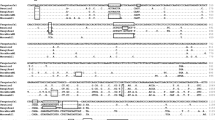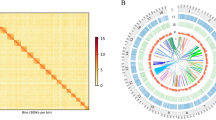Abstract
As a special reference of the nuclear cistron rDNA of cyclopoid copepods, we obtained the entire DNA sequence of a single rDNA repeat unit from Paracyclopina nana (Cyclopoida: Cyclopettidae). The genomic organization of P. nana rDNA (7,974 bp, 51.7% of GC) was observed to be 18S–ITS1–5.8S–ITS2–28S–IGS in order. Comparative analyses of the rDNA between P. nana and other copepods showed that the intergenic spacer (IGS) was highly informative and divergent, while other coding regions are relatively conserved. We detected eleven poly(T) tracts in the IGS, demonstrating the high AT content in this region. In addition, many sub-repeat sequence patterns (e.g., AG, AT, GC, CCG, TC) such as microsatellites were identified from the rDNA IGS of P. nana. In this article, we show the first complete sequence of rDNA from the order Cyclopoida, providing a better understanding of molecular characteristics in molecular taxonomy.


Similar content being viewed by others
References
Boxshall, G. O. & S. H. Halsey, 2004. An Introduction to Copepod Diversity, Vols. I, II. The Ray Society of London, London: 1–966.
Braga, E., R. Zardoya, A. Meyer & J. Yen, 1999. Mitochondrial and nuclear rRNA based copepod phylogeny with emphasis on the Euchaetidae (Calanoida). Marine Biology 133: 79–90.
Bucklin, A., B. W. Frost, J. Bradford-Grieve, L. D. Allen & N. J. Copley, 2003. Molecular systematics and phylogenetic assessment of 34 calanoid copepod species of the Calanidae and Clausocalanidae. Marine Biology 142: 333–343.
Burton, R. S., E. C. Metz, J. M. Flowers & C. S. Willett, 2005. Unusual structure of ribosomal DNA in the copepod Tigriopus californicus: intergenic spacer sequences lack internal subrepeats. Gene 344: 105–113.
Copepod Web Portal (CWP). http://www.luciopesce.net/copepods/.
Drouin, G., J. D. Hofman & W. F. Doolittle, 1987. Unusual ribosomal RNA gene organization in copepods of the genus Calanus. Journal of Molecular Biology 196: 943–946.
Dussart, B. H., 1969. Les Copépodes des Eaux Continentales de Europe Occidentals, Vol. 2. Cyclopoides et Biologie, Boubeé, Paris: 292.
Dussart, B. & D. Defaye, 2006. World Directory of Crustacea Copepoda of Inland Waters II—Cyclopiformes. Backhuys Publishers, Leiden: 354 pp.
Fiers, F., J. W. Reid, T. M. Iliffe & E. Suárez-Morales, 1996. New hypogean cyclopoid copepods (Crustacea) from the Yucatan Peninsula, Mexico. Contributions to Zoology 66: 65–102.
Humes, A. G., 1994. How many copepods? Hydrobiologia 292(293): 1–7.
Huys, R., J. Llewellyn-Hughes, P. D. Olson & K. Nagasawa, 2006. Small subunit rDNA and Bayesian inference reveal Pectenophilus ornatus (Copepoda incertae sedis) as highly transformed Mytilicolidae, and support assignment of Chondracanthidae and Xarifiidae to Lichomolgoidea (Cyclopoida). Biological journal of the Linnean Society 87: 403–425.
Huys, R., J. Llewellyn-Hughes, S. Conroy-Dalton, P. D. Olson, J. N. Spinks & D. A. Johnston, 2007. Extraordinary host switching in siphonostomatoid copepods and the demise of the Monstrilloida: integrating molecular data, ontogeny and antennulary morphology. Molecular Phylogenetics and Evolution 43: 368–378.
Ki, J.-S., H. G. Park & J.-S. Lee, 2009a. The complete mitochondrial genome of the cyclopoid copepod Paracyclopina nana: a highly divergent genome with novel gene order and atypical gene numbers. Gene 435: 13–22.
Ki, J.-S., I.-C. Kim & J.-S. Lee, 2009b. Comparative analysis of nuclear ribosomal DNA from the moon jelly Aurelia sp. 1 (Cnidaria: Scyphozoa) with characterizations of the 18S, 28S genes and the intergenic spacer (IGS). Hydrobiologia 206: 229–239.
Ki, J.-S., K.-W. Lee, H. G. Park, S. Chullasorn, H.-U. Dahms & J.-S. Lee, 2009c. Phylogeography of the copepod Tigriopus japonicus along the Northwest Pacific rim. Journal of Plankton Research 31: 209–221.
Kiefer, F., 1927. Versuch eines Systems der Cyclopiden. Zoologischer Anzeiger 73: 302–308.
Lee, K.-W., H. G. Park, S. M. Lee & H. K. Kang, 2006. Effects of diets on the growth of the brackish water cyclopoid copepod Paracyclopina nana Smirnov. Aquaculture 256: 346–353.
Monchenko, V. I., 1974. The fauna of Ukraine. Naukova dumka (Kiev) 27: 1–449.
Pinto, C. S. C., L. P. Souza-Santos & P. J. P. Santos, 2001. Development and population dynamics of Tisbe biminiensis (Copepoda: Harpacticoida) reared on different diets. Aquaculture 198: 253–267.
Raué, H. A., W. Musters, C. A. Rutgers, J. Van’t Riet & R. J. Planta, 1990. rRNA: from structure to function. In Hill, W. E., A. Dahlberg, R. A. Garrett, P. B. Moore, D. Schlessinger & J. R. Warner (eds), The Ribosome, Structure, Function and Evolution. American Society of Microbiology, Washington: 217–235.
Reid, J. W., 1994. Latitudinal diversity patterns of continental benthic copepod species assemblages in the Americas. Hydrobiologia 292(293): 341–349.
Rylov, V. M., 1948. Fauna USSR. Crustaceana. Cyclopoida of freshwater. Moscow-Leningrad 3: 318. (in Russian).
Song, Y., G. T. Wang, W. J. Yao, Q. Gao & P. Nie, 2008. Phylogeny of freshwater parasitic copepods in the Ergasilidae (Copepoda: Poecilostomatoida) based on 18S and 28S rDNA sequences. Parasitology Research 102: 299–306.
Sun, B. & J. W. Fleeger, 1995. Sustained mass culture of Amphiascoides atopus, a marine harpacticoid copepod in a recirculating system. Aquaculture 136: 313–321.
Yeatman, H. C., 1959. Free-living Copepoda: Cyclopoida. In Edmondson, W. T. (ed.), Ward and Whipple’s Freshwater Biology. Wiley, New York: 795–815.
Acknowledgments
We thank Mr. Winson K. Chan for his comments on the manuscript. This work was supported by a grant of Korea Research Foundation funded to Huem Gi Park (KRF-2006-C00699). Jang-Seu Ki was a recipient of a post-doctoral fellowship funded by the Korea Research Foundation Grant (KRF-2007-355-C00059).
Author information
Authors and Affiliations
Corresponding authors
Additional information
Guest editors: L. Sanoamuang & J.S. Hwang / Copepoda: Biology and Ecology
Rights and permissions
About this article
Cite this article
Ki, JS., Park, H.G. & Lee, JS. Extensive analysis of nuclear cistron rDNA sequence of Paracyclopina nana (Cyclopoida: Cyclopettidae). Hydrobiologia 666, 3–9 (2011). https://doi.org/10.1007/s10750-010-0563-6
Published:
Issue Date:
DOI: https://doi.org/10.1007/s10750-010-0563-6




